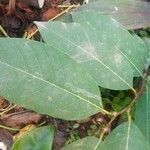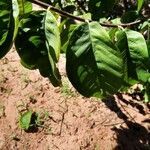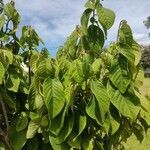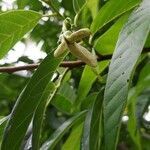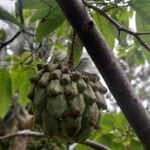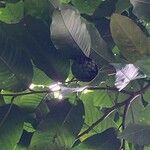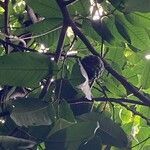Evergreen or semi-deciduous, hairy shrub to c. 4 m high, forming large thickets by suckering. Bark tough and fibrous. Shoots tomentose. Petiole 5-15 mm long. Lamina (3)-6-21-(26) × (1.5)-3-12-(18) cm, ovate-elliptic, elliptic, or obovate, glaucous and densely hairy beneath, becoming sparingly so above; base broadly cuneate; apex rounded to obtuse. Fls usually solitary, sometimes 2 together, opposite upper lf axils. Pedicels 6-10 mm long, brown-tomentose. Calyx 2-3 mm long; lobes brown-tomentose. Outer 3 petals c. 2.5 × 0.8 cm, thick, fleshy, green, tomentulose outside; inner 3 petals minute. Filaments very short; connectives densely silky hairy. Carpels brown-tomentose. Fr. ± segmented, broadly ovate-cordate, c. 8 cm diam.
A small deciduous tree up to 6-10 m tall. In some locations trees keep their leaves throughout the year. It has a brown velvety tomentum on the under surface of the leaves. The leaves are 8-20 cm long and up to 10 cm wide. There is a single leaflet. The flowers occur either singly or 2-3 together along the branches. The female parts of the flower open first then the male parts. The fruit is 8-15 cm across with black or brown seeds in white flesh. The fruit is cone or heart shaped. It can be 10-20 cm long by 10 cm wide. Fruit can weigh 0.5 kg. The skin can have finger like markings. The flesh is juicy and each segment has one seed. There can be 20-40 large brown seeds in each fruit.
A small tree. It can be 3-10 m tall. The fruit is large and with segments. It is sweet. These are hybrid trees which bear characteristics between cherimoyas and sweetsops. They are semi-deciduous losing many of their leaves during the year. Flowering often occurs as a new flush of leaves is produced. The flesh of the fruit is soft and creamy and sweet. Several named cultivars occur.
